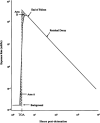A Methodology for Estimating External Doses to Individuals and Populations Exposed to Radioactive Fallout from Nuclear Detonations
- PMID: 34898516
- PMCID: PMC8677613
- DOI: 10.1097/HP.0000000000001504
A Methodology for Estimating External Doses to Individuals and Populations Exposed to Radioactive Fallout from Nuclear Detonations
Abstract
A methodology of assessment of the doses from external irradiation resulting from the ground deposition of radioactive debris (fallout) from a nuclear detonation is proposed in this paper. The input data used to apply this methodology for a particular location are the outdoor exposure rate at any time after deposition of fallout and the time-of-arrival of fallout, as indicated and discussed in a companion paper titled "A Method for Estimating the Deposition Density of Fallout on the Ground and on Vegetation from a Low-yield Low-altitude Nuclear Detonation." Example doses are estimated for several age categories and for all radiosensitive organs and tissues identified in the most recent ICRP publications. Doses are calculated for the first year after the detonation, when more than 90% of the external dose is delivered for populations close to the detonation site over a time period of 70 y, which is intended to represent the lifetime dose. Modeled doses in their simplest form assume no environmental remediation, though modifications can be introduced. Two types of dose assessment are considered: (1) initial, for a rapid but only approximate dose estimation soon after the nuclear detonation; and (2) improved, for a later, more accurate, dose assessment following the analysis of post-detonation measurements of radiation exposure and fallout deposition and the access of information on the lifestyle of the exposed population.
Copyright © 2021 Written work prepared by employees of the Federal Government as part of their official duties is, under the U.S. Copyright Act, a “work of the United States Government” for which copyright protection under Title 17 of the United States Code is not available. As such, copyright does not extend to the contributions of employees of the Federal Government.
Conflict of interest statement
The authors declare no conflicts of interest.
Figures









Similar articles
-
Dose Estimation for Exposure to Radioactive Fallout from Nuclear Detonations.Health Phys. 2022 Jan 1;122(1):1-20. doi: 10.1097/HP.0000000000001501. Health Phys. 2022. PMID: 34898514 Free PMC article.
-
A Method for Estimating the Deposition Density of Fallout on the Ground and on Vegetation from a Low-yield, Low-altitude Nuclear Detonation.Health Phys. 2022 Jan 1;122(1):21-53. doi: 10.1097/HP.0000000000001496. Health Phys. 2022. PMID: 34898515 Free PMC article.
-
Estimated Radiation Doses Received by New Mexico Residents from the 1945 Trinity Nuclear Test.Health Phys. 2020 Oct;119(4):428-477. doi: 10.1097/HP.0000000000001328. Health Phys. 2020. PMID: 32881738 Free PMC article.
-
Review of methods of dose estimation for epidemiological studies of the radiological impact of nevada test site and global fallout.Radiat Res. 2006 Jul;166(1 Pt 2):209-18. doi: 10.1667/RR3172.1. Radiat Res. 2006. PMID: 16808609 Review.
-
Historical overview of atmospheric nuclear weapons testing and estimates of fallout in the continental United States.Health Phys. 2002 May;82(5):591-608. doi: 10.1097/00004032-200205000-00007. Health Phys. 2002. PMID: 12003011 Review.
Cited by
-
Comparison of external dose estimates using different retrospective dosimetry methods in the settlements located near Semipalatinsk Nuclear Test Site, Republic of Kazakhstan.J Radiat Res. 2024 Jan 19;65(1):36-46. doi: 10.1093/jrr/rrad082. J Radiat Res. 2024. PMID: 37981331 Free PMC article.
-
The overview of neutron-induced 56Mn radioactive microparticle effects in experimental animals and related studies.J Radiat Res. 2022 Aug 13;63(Supplement_1):i1-i7. doi: 10.1093/jrr/rrac020. J Radiat Res. 2022. PMID: 35968985 Free PMC article.
-
A Methodology for Calculation of Internal Dose Following Exposure to Radioactive Fallout from the Detonation of a Nuclear Fission Device.Health Phys. 2022 Jan 1;122(1):84-124. doi: 10.1097/HP.0000000000001503. Health Phys. 2022. PMID: 34898517 Free PMC article.
-
Parameter Values for Estimation of Internal Doses from Ingestion of Radioactive Fallout from Nuclear Detonations.Health Phys. 2022 Jan 1;122(1):236-268. doi: 10.1097/HP.0000000000001493. Health Phys. 2022. PMID: 34898519 Free PMC article.
-
A Historical Survey of Key Epidemiological Studies of Ionizing Radiation Exposure.Radiat Res. 2024 Aug 1;202(2):432-487. doi: 10.1667/RADE-24-00021.1. Radiat Res. 2024. PMID: 39021204 Free PMC article. Review.
References
-
- Andersson KG, Roed J, Eged K, Kis Z, Voigt G, Meckbach R, Oughton DH, Hunt J, Lee R, Beresford NA, Sandalls. Physical countermeasures to sustain acceptable living and working conditions in radioactively contaminated residential areas. Roskilde, Denmark: Risø National Laboratory; Risø-R-1396(EN); 2003.
-
- Andersson KG, Ammann M, Backe S, Rosén K. Decision support handbook for recovery of contaminated inhabited urban areas. Roskilde, Denmark: Risø National Laboratory; Nordic nuclear safety research report NKS-175; 2008.
-
- Anspaugh LR, Church BW. Historical estimates of external gamma exposure and collective external gamma exposure to communities downwind of the Nevada Test Site. I. Test series through Hardtack II, 1958. Las Vegas, NV: US Department of Energy, Nevada Operations Office; Report NVO-226; 1985. Available from www.osti.gov/serlets/purl/6386454-COiQU2. Accessed 6 September 2020. - PubMed
-
- Apostoaei AI, Kocher DC. Radiation doses to skin from dermal contamination. Washington, DC: Defense Threat Reduction Agency; Technical Report HDTRA1-07-C-0015; 2010.
Publication types
MeSH terms
Substances
Grants and funding
LinkOut - more resources
Full Text Sources

